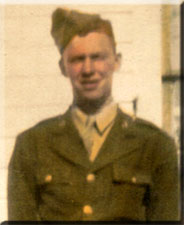
Donald Corcoran's Story ...
told by his niece Susan and his great-niece Misty ...
Donald was born on September 13, 1925 at the home of his parents, Joseph and Edith. He grew up with his parents and younger sister Catherine in Waterbury, Connecticut. Donald and his sister Catherine grew up in the hard days of the depression in the States. Donald's father Joseph had served in World War I in the U.S. Army Med Department
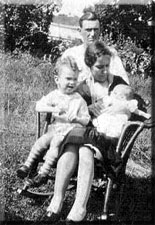 Donald with his parents Joseph and Edith Corcoran
Donald with his parents Joseph and Edith Corcoranand his younger sister Catherine
Donald attended grammar school, after that he attended Leavenworth Technical High School, CT. His enlistment records show that Donald spent four years studying in High School.
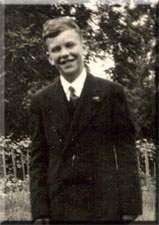
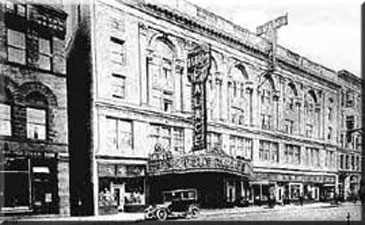
left: Donald in his younger years
right: Palace Theatre, Waterbury, CT
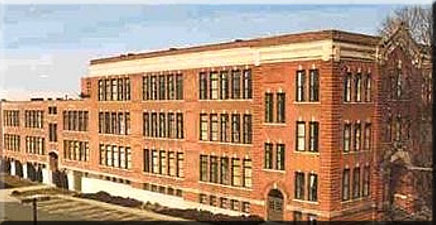 Leavenworth Technical High School, CT
Leavenworth Technical High School, CTOn Tuesday 16 November 1943 at the age of 18, he enlisted in the U.S. Army in the city of New Haven, Connecticut. After having received basic training Donald was transported to England where he was assigned to the 28th Infantry Division.
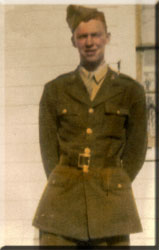 Donald in his US Army uniform
Donald in his US Army uniformDonald and his division after training in Southampton England, landed in Normandy, France, 22 July 1944, and entered the hedgerow struggle north and west of St. Lo. Inching their way forward against desperate opposition, the men of the 28th took Percy, 1 August, and Gathemo, 10 August. On the 12th, Brigadier General Wharton was killed a few hours after assuming command. The Division began to roll north and east, 20 August, meeting light resistance except at Le Neubourg, 24 August, and Elbeuf on the 25th.
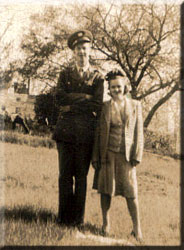 Donald back home with his sister Catherine
Donald back home with his sister CatherineAfter parading through Paris, 29 August 1944 the 28th continued its sustained drive through France and Luxembourg to the German border, assembling near Binsfeld, 11 September 1944: It began hammering at the Siegfried Line, 12 September, destroying pillboxes and other fortifications, moved north to Elsenborn, 1 October, then returned on the 6th for patrols and rotation of troops. The first phase of the battle of the Hürtgen Forest concentrated on the town of Schmidt, astride an important German supply route, within the southern part of the forest. The engagement began on September 19, 1944, with a probe by the U.S. 60th Infantry Regiment that entered the Hürtgen Forest but was beaten back by the terrain and opposition.
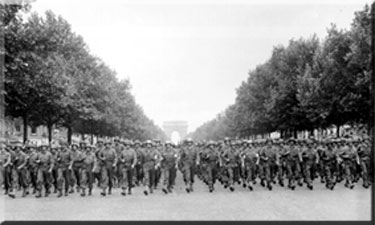 Victory parade of the 28th Infantry Division
Victory parade of the 28th Infantry DivisionParis, Tuesday August 29, 1944
On October 5, the U.S. 9th Infantry Division attacked the town of Schmidt using the 60th and 39th Infantry Regiments while the 47th held a defensive position. The Monschau-Düren road was quickly cut but both regiments were slowed by defenses and suffered significant casualties: the 60th's 2nd battalion was reduced to a third after the first day. The 39th was halted at the Weisser Weh stream; there were problems with narrow paths, air bursts in trees, and fire breaks which were blocked or enfiladed. Evacuation and supply was difficult or impossible.
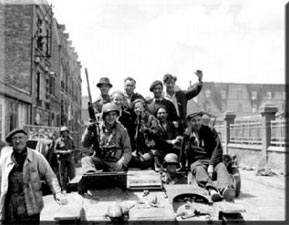 GI's of the 9th Infantry Division in France
GI's of the 9th Infantry Division in Francethey were to be relieved by Donald's 28th Infantry Division
The slogging match continued. By October 16, 3.000 yards had been gained at the cost of 4,500 casualties. The U.S. 28th Infantry Division, a Pennsylvania National Guard unit, arrived on October 16 to relieve the battered 9th. Donald's unit, the 112th Infantry Regiment of the 28th Infantry Division was reinforced with armor, tracked transport Weasels and air support. Of its three regiments, one was deployed to protect the northern flank, another to attack Germeter, and the third to capture Schmidt, the main objective. The area had terrible terrain with the Kall Trail running along a deep river ravine. This was not tank country, despite the need for armor to support the infantry.
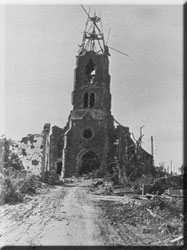 the church of Vossenack - 1944
the church of Vossenack - 1944A track from a U.S. armored vehicle that was hit and burned in the Kall Valley. The track section melted into the road and is still visible today. The attack by 28th Division started on November 2; the defenders were expecting it and were ready. The U.S. 109th Infantry Regiment was impeded after 300 yards by an unexpected minefield, pinned down by mortar and artillery fire and harassed by local counterattacks. One mile was gained after two days, after which the 109th dug-in and endured casualties.
 GI's resting in the Hürtgen Forest
GI's resting in the Hürtgen ForestThe 112th Infantry Regiment attacked Vossenack and the neighboring ridge, which were captured on November 2. The 112th was then halted on the Kall by strong defenses and difficult terrain. The U.S. 110th Infantry Regiment had to clear the woods next to the River Kall, capture Simonskall, and maintain a supply route for the advance on Schmidt; again these were very difficult tasks due to weather, prepared defenses, determined defenders, and terrain. The weather prevented tactical air support until November 5.
 American tanks moving up the Kall Trail
American tanks moving up the Kall TrailThe 112th captured Schmidt on November 3, cutting the German supply route to Monschau but no American supply, reinforcement or evacuation was possible as the Kall Trail was blocked. A strong German counterattack by tanks of 116th Panzer Division and infantry from 89th Division rapidly expelled the Americans from Schmidt and they were unable to counterattack. For two days, the 112th remained hard pressed to hold its positions outside Schmidt, however the battle had to continue without Donald E Corcoran who was killed during the fierce counter attack by the Germans, in the morning of Saturday November 4, 1944 ...
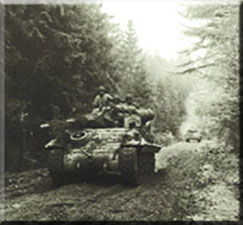 American tanks near Kommerscheidt and Schmidt
American tanks near Kommerscheidt and SchmidtTwo days after Donald was killed, on November 6, the U.S. 12th Infantry Regiment was detached from the U.S. 4th Division and sent to reinforce the 28th Division. At Vossenack, the 2nd battalion of the 112th disintegrated after constant shelling and fled a German attack. Following the providential arrival of two U.S. armored platoons of tanks and M10 Wolverine tank destroyers, supported by those 2nd battalion men who had held tight, and two companies of 146th Engineers operating as infantry, the Americans held on and the fighting for Schmidt continued until November 10, 1944 … The Battle for the Hürtgen Forest lasted until February 1945 ...
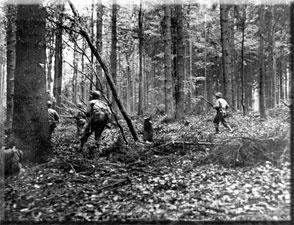 GI's trying to find their way in the Hürtgen Forest
GI's trying to find their way in the Hürtgen ForestThese days Donald E Corcoran rests in the beautiful American Military Cemetery at Henri-Chapelle. He is remembered and honored by his entire family and every visitor of the American Cemetery at Henri-Chapelle and by every visitor of the In Honored Glory website.
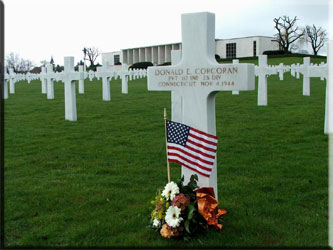 PVT Donald E Corcoran's final resting place in Henri-Chapelle
PVT Donald E Corcoran's final resting place in Henri-ChapelleSpecial thanks to Donald's sister Catherine who passed away
in 1981
without knowing what happened to her brother and where he was buried.
Special thanks as well to
Catherine's daughter Susan and
her granddaughter Misty Smitley.
published March 29, 2008